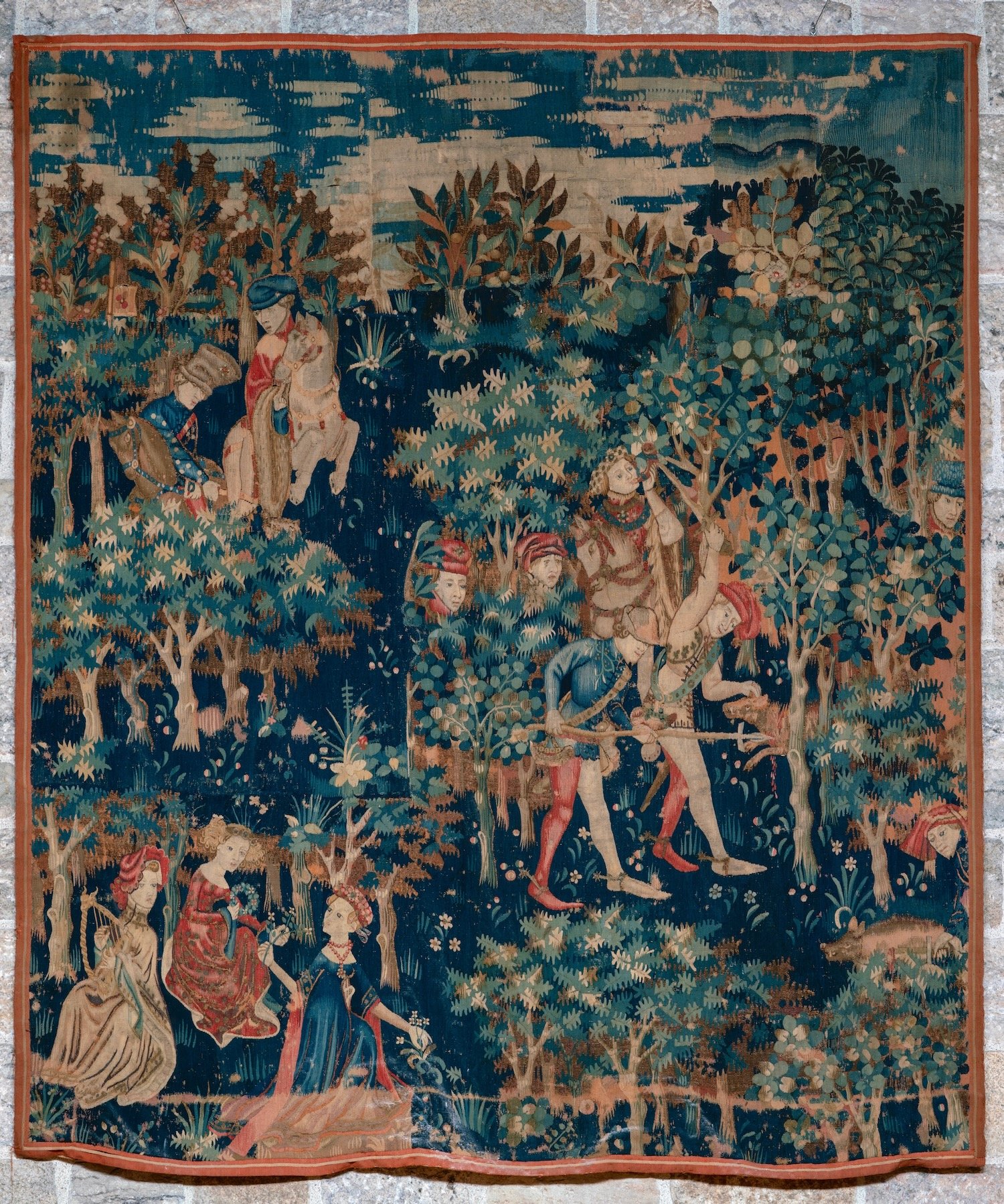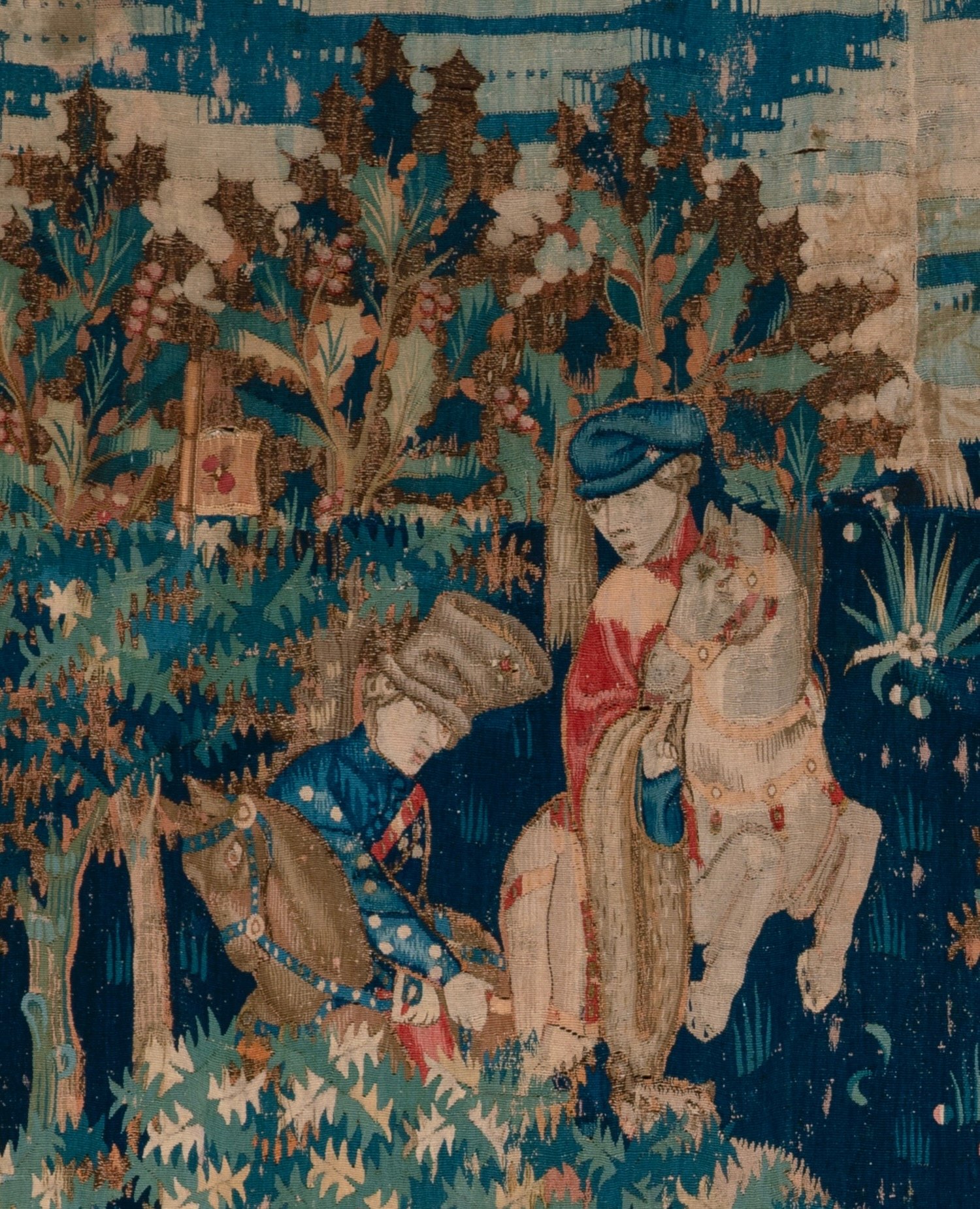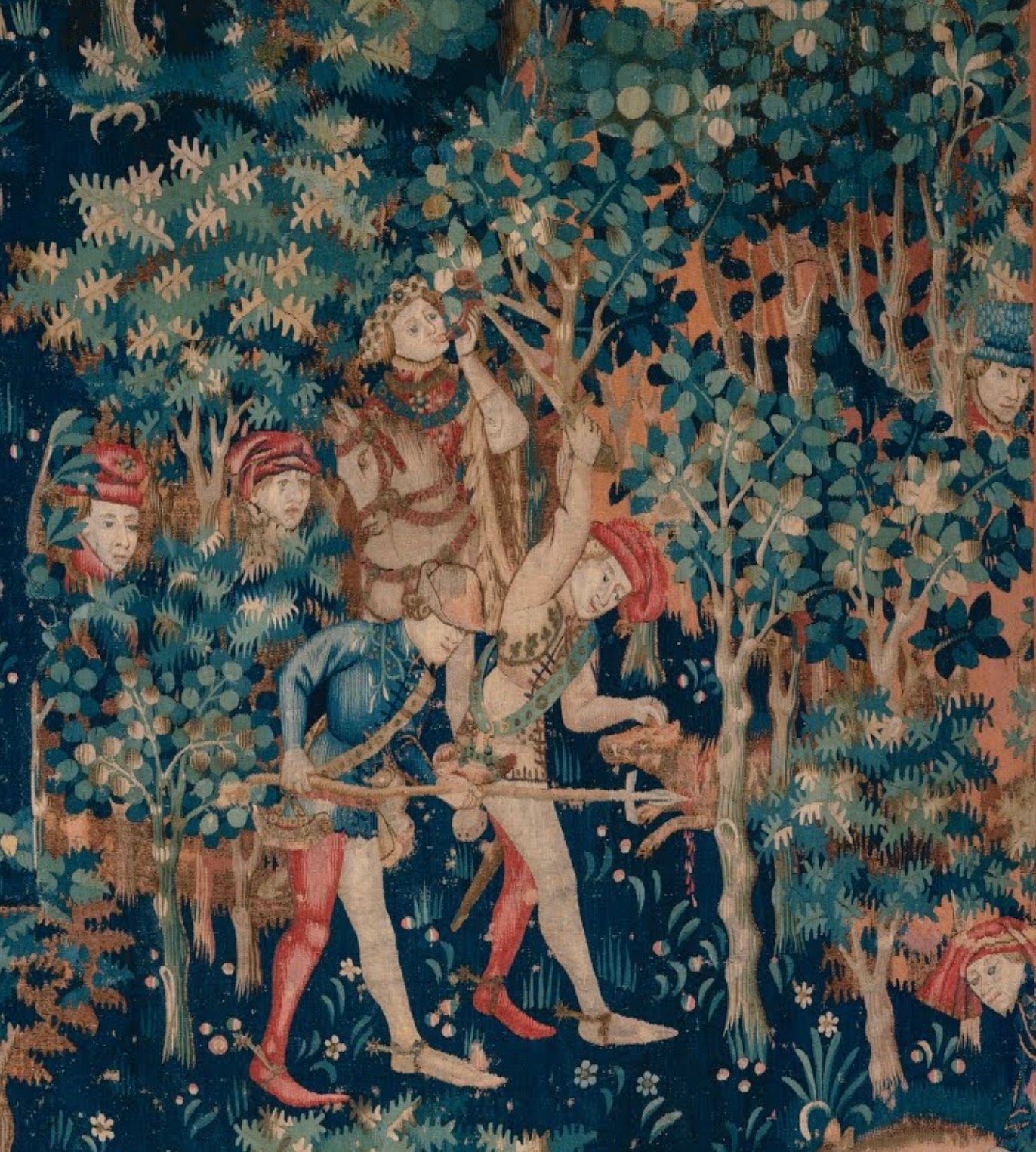Glencairn Museum News | Number 6, 2024
Glencairn’s third-floor Library is home to an early 15th-century tapestry depicting a boar hunt, likely created in the South Netherlands or northern France. When the Pitcairn family lived at Glencairn, the tapestry was displayed alternately above the Library fireplace and the one in the first-floor Upper Hall.
It is an often-repeated misconception that landscape representation in medieval art existed only in the backgrounds of religious paintings, and was relocated from this marginal space into the center of representation during the sixteenth and seventeenth centuries. A tapestry made in the South Netherlands or northern France in the early fifteenth century, today on display in the library of Glencairn Museum, challenges this misconception (Figure 1). Known as the Boar Hunt tapestry, this roughly 7’ x 8.25’ woven depiction of aristocratic disportment in a rural landscape presents us with a rare example of a largely lost and unrecognized tradition of landscape representation that preceded the modern European genre of landscape painting. Like the tapestry in Glencairn Museum, artworks within this tradition consisted of large-scale secular depictions of labor and leisure in rural landscapes that would have blanketed the walls of rooms within aristocratic castles and urban residences. The earliest surviving examples of these immersive secular landscapes are mural paintings found in fourteenth-century castles in southern France and south-central Europe (Figures 2–3). Around 1400, large-scale tapestries of a similar style and subject were first produced for aristocratic patrons in northern France and the South Netherlands. As one of the earliest surviving examples from this tradition, the Boar Hunt tapestry provides us with a unique opportunity to access this largely forgotten late medieval tradition of depicting rural activities and spaces in woven images.
Figure 1. Boar Hunt Tapestry, Franco-Flemish, probably Arras, c. 1400–1425. Bryn Athyn, PA, Glencairn Museum, 10.TP.371.
Figure 2. The Chambre du cerf frescos, Palais des Papes, Avignon, France, c. 1343. Author’s photograph.
Figure 3. The Torre aquila frescos, Castello del Buonconsiglio, Trent, Italy, c. 1391–1407. Author’s photograph.
Tapestries depicting subjects set in verdant rural landscapes such as shepherds herding sheep and elites hunting deer are often referred to in fifteenth-century documents as verdures or “greeneries.” Although very few survive today, especially from the early period of their production in the later fourteenth and early fifteenth centuries, inventory records suggest that verdures were produced by the hundreds in France and the South Netherlands during the first half of the fifteenth century for local aristocrats and for export to elite collectors across Europe. Of the small number of these woven landscapes to survive today, most are mere fragments of their original displays. We know from inventory descriptions that verdures were often commissioned as sets or “chambre” that would blanket all of the walls and furniture of a room with an installation of blooming surfaces. Depictions of these tapestries in fifteenth-century paintings help us to visualize what a full chambre of vegetal tapestries would have looked like. A series of Flemish tapestries depicting aristocrats hunting with dogs and falcons in a multi-tiered, hyper-vegetated landscape similar in subject and style to the Boar Hunt tapestry is depicted in a Spanish manuscript painted around 1450 (Figure 4). In their original, enveloping format, these tapestries would have lined and defined the space inhabited by represented figures and real human bodies alike, encircling them in a stage set of living turf.
Figure 4. Leonardo Crespi, detail of interior with figural millefleurs tapestries from the Prayer Book of Alphonso V of Aragon, Spain (Valencia), 1436–43. London, The British Library, Add. Ms. 28962, fol. 14v.
Glencairn Museum’s Boar Hunt tapestry might have originally been part of a larger set of tapestries that covered the walls of a room with scenes of aristocratic activities in rural landscapes. Such a set could have included depictions of falconry, dancing, and game playing in addition to hunting, listening to music, and picking flowers. Indeed, it is possible that the textile fragment on the upper left of the current hanging depicting two men on horseback originally belonged to a different tapestry in the same series, that was incorporated into the current hanging during modern restorations (Figure 5). The chambre that the Boar Hunt tapestry may have once composed might have looked something like the display of a rare surviving—although also fragmentary and patchworked—series of early verdure tapestries in the Musée des Arts Decoratifs (Figure 6). These tapestries, which are extremely similar in style and subject to the Boar Hunt tapestry, depict men and women in courtly dress hunting with falcons, listening to music, and socializing in blooming fields and woodland meadows. A walled city is emphasized in the background of one of these hangings, as if to specify that the tapestries’ scenes take place specifically in the landscape outside of city and garden walls (Figure 7).
Figure 5. Detail of figures on horseback in a segment of the tapestry belonging to a different part of the original series, in the Boar Hunt tapestry, Franco-Flemish, probably Arras, c. 1400–1425. Bryn Athyn, PA, Glencairn Museum, 10.TP.371.
Figure 6. The “Courtly Romance” tapestries, Paris, 1400–1410. Paris or the South Netherlands, Musée des Arts Décoratifs, inv. PE 602–605. Author’s photograph.
Figure 7. Hanging with an engagement (?) from the “Courtly Romance” tapestries, Paris or the South Netherlands, 1400–1410. Paris, Musée des Arts Décoratifs, inv. PE 603. Author’s photograph.
While the tapestry hanging in Glencairn Museum appears complete, the current object consists of a patchwork quilt of 56 tapestry fragments (Figure 8). Numerous small pieces of the tapestry just below the treeline are rewoven, or derive from different pieces of the same or a similar hanging. Additionally, the red border surrounding the tapestry was added during 19th-century restorations. We are fortunate that the largest piece of the current hanging, including the three women on the lower left of the tapestry and the six men hunting boar on the tapestry’s lower and middle right, are all part of a single original piece. This backwards “L”-shaped section depicts two scenes of aristocratic leisure in an efflorescent rural landscape. On the right, seven men bedecked in preciously embroidered and jewel-encrusted garb engage in a boar hunt (Figure 9). On the lower left, three women in lavish dress are seated directly on the ground of a blooming meadow abutting a small grove of trees (Figure 10). As the figure on the far left delicately plucks at the strings of a lyre, the two others pluck and exchange flowers between their fingertips with equal precision, while one of them weaves these flowers into a wearable crown.
Figure 8. The major pieces that compose the current Boar Hunt tapestry in Glencairn Museum. There are many smaller pieces that make up each of these major sections.
Figure 9. Detail of men hunting boar in the Boar Hunt tapestry, Franco-Flemish, probably Arras, c.1400–1425. Bryn Athyn, PA, Glencairn Museum, 10.TP.371.
Figure 10. Detail of women picking flowers in the Boar Hunt tapestry, Franco-Flemish, probably Arras, c. 1400–1425. Bryn Athyn, PA, Glencairn Museum, 10.TP.371.
These scenes all evoke activities that the original owners of this tapestry likely engaged in. Boar hunting was one of the favorite pastimes of the aristocrats who ruled in Northern France and the South Netherlands during this period. This practice is depicted in an illustrated hunting manual written by the Count of Foix towards the end of the fourteenth century (Figures 11–12). The depictions of the boar hunt in this manuscript are strikingly similar to the tapestry in Glencairn Museum. Indeed, the particularly detailed description of blooming groundcover vegetation in these miniature paintings, paired with their flat spatial construction, has led numerous art historians to posit that they were modeled on, or inspired by, tapestries. This relationship with hunting manuals that the elite patrons of these artworks actually used helps to reveal the artwork’s connection with the very real landscapes and activities the tapestry represents.
Figure 11. Gaston Phébus, Livre de la chasse, early 15th century. Bibliothèque nationale de France, France, 1331–1391 ms. fr. 616, fol. 66r, detail.
Figure 12. Gaston Phébus, Livre de la chasse, early 15th century. Bibliothèque nationale de France, France, 1331–1391 ms. fr. 616, fol. 73r, detail.
The three women on the lower left corner of the Glencairn Museum tapestry listening to music, picking flowers, and weaving flower crowns in a rural meadow also reflect activities in which the patrons of artworks like this actually engaged. Such practices had both implications of religious devotion and secular pastime. For example, a chronicle written around 1405 relays that the wife of the admiral of France would regularly go out with a group of ladies with their rosaries and Books of Hours and pick flowers, and then afterwards they would ride through the country with knights, making chaplets, listening to music, dancing, and hunting with falcons. These activities are commonly depicted in fifteenth-century illustrated calendars, in sequences that included other seasonal activities that took place in rural landscapes, such as falconry and boar hunting (Figures 13–14). However, the tapestry in Glencairn Museum is far from a record of an actual event. This is demonstrated most obviously in the fact that boar hunting was an autumn activity in late medieval Europe, while activities in blooming meadows mostly took place in spring and summer. Rather than depicting a snapshot of a specific moment, the tapestry conveys a cultural landscape at numerous moments in time on a continuous plain.
Figure 13. Master of the Brussels Initials and French Associates, April, Hours of Charles the Noble, King of Navarre, Paris, c. 1405. The Cleveland Museum of Art, fol. 4r, detail.
Figure 14. Master of the Brussels Initials and French Associates, May, Hours of Charles the Noble, King of Navarre, Paris, c. 1405. The Cleveland Museum of Art, fol. 5r, detail.
When we compare the Boar Hunt tapestry with other surviving early fifteenth-century verdures, we can appreciate how its subject-matter and aesthetic goals are part of a larger tradition. The Honor Making a Chaplet of Roses and Falcon’s Bath tapestries in the Metropolitan Museum of Art in New York, also made in the South Netherlands in the first quarter of the fifteenth century, depict scenes of aristocratic leisure in fields of blooming vegetation (Figures 15–16). All of these tapestries set their scenes of aristocratic disportment—both real and imaginary—in a landscape that envelops human figures in a sea of green. Although these tapestries each relate in some way to descriptions of these activities and their landscape settings in the romance poetry popular in fifteenth-century courts, these poems and their cognates in visual representation all relate to the actual experiences of their patrons in rural landscapes. And like the poems that they are related to, which almost always begin with a detailed description of the meadows in which the poems take place, these tapestries take special care to represent in microscopic detail the plants that compose the ground of a blooming field in spring or summer.
Figure 15. Honor Making a Chaplet of Roses, South Netherlandish, c. 1410–20. New York, The Cloisters Collection at the Metropolitan Museum of Art, 59.85.
Figure 16. The Falcon’s Bath, South Netherlandish, c. 1400–1415. New York, The Cloisters Collection at the Metropolitan Museum of Art, 2011.93.
While it is easy to assume that the bucolic landscape settings of these tapestries serve as “background” secondary to the figural scenes in their representational “centers,” isn’t it just as possible that these generic scenes of courtly entertainment were used as an excuse to create an image of a meadow in bloom? These tapestries represent vegetal detail with equal care to that of the human form and, before being cut down into the fragments that survive today, likely devoted more of their surfaces to flowering herbs and grasses than human bodies and actions. The centrality, rather than marginality, of the landscape in these artworks is corroborated in fifteenth-century inventories, which Catherine Reynolds has noted often describe woven tapestries depicting activities of labor or leisure in rural spaces first and foremost as landscapes (“green fields with. . .” or “images of greenery with. . .”), suggesting that their depiction of the land itself remained of primary significance even when they integrated narrative subjects.
The Boar Hunt tapestry at Glencairn Museum offers us an opportunity to glimpse a tradition of landscape representation in monumental woven media that directly preceded, and coexisted with, the emergence of the modern genre of landscape painting in Northern Europe. Rather than serving as backgrounds of secondary significance to the religious imagery in their centers, these tapestries both literally and figuratively foreground the surface of the land. Not only do their subjects of labor and leisure in bucolic landscapes prefigure the coming landscape genre, their physical format hanging on the walls of elite domestic spaces foreshadows it as well. However, unlike the modern landscape painting, which gives the impression of leading like a window onto a landscape beyond the four walls of a room, these tapestries transformed rooms themselves into immersive landscapes, in which viewers could remember their own physical experiences in such spaces, and imagine new possibilities of understanding and interacting with them. As a rare surviving and beautifully-preserved example from this tradition of landscape representation, the Boar Hunt tapestry can teach us an alternative way of looking at and inhabiting the land, in which humankind is situated directly inside—not distanced or excluded from—its verdant surfaces.
Isabella Mimi Weiss
PhD Candidate in Art History
Rutgers University, New Brunswick
Select Bibliography
Blanc, Monique. Tapisseries du Moyen Âge et de la Renaissance: collection du musée des Arts décoratifs (Paris: MAD, 2019 ), cat. no. 40, p. 108.
Reynolds, Catherine. “Patinir and Depictions of Landscape in the Netherlands,” in Patinir: Essays and Critical Catalogue, ed. Alexander Vergara (Madrid: Museo Nacional del Prado, 2007).
Cavallo, Adolph S. Medieval Tapestries in the Metropolitan Museum of Art. New York: H.N. Abrams, 1993.
Díaz de Gámez, Gutierre, and Joan Evans. The Unconquered Knight: A Chronicle of the Deeds of Don Pero Niño, Count of Buelna. Boydell Press, 1928.
Gómez-Moreno, Carmen. Medieval Art from Private Collections: a special exhibition at The Cloisters, October 30, 1968 through January 5, 1969. New York: The Metropolitan Museum of Art, 1968, cat. no. 208.
James, E. O. Seasonal Feasts and Festivals. Detroit: Omnigraphics, 1993, pp. 291–316.
Klemettilä, Hannele. Animals and hunters in the late Middle Ages: evidence from the BnF MS fr. 616 of the Livre de chasse by Gaston Fébus, New York : Routledge, Taylor & Francis Group, 2015.
Weigert, Laura. “Chambres d'amour: Tapestries of Love and the Texturing of Space.” Oxford Art Journal vol. 31, no. 3: 317–36.
Would you like to receive a notification about new issues of Glencairn Museum News in your email inbox? If so, click here. A complete archive of past issues of Glencairn Museum News is available online here.

















